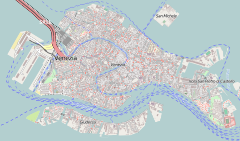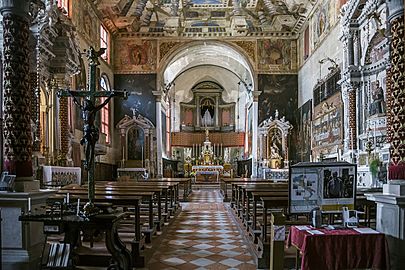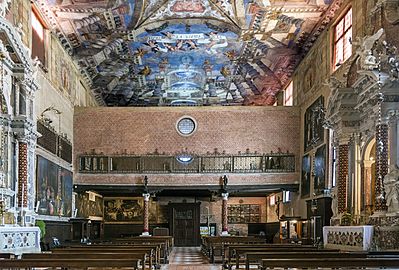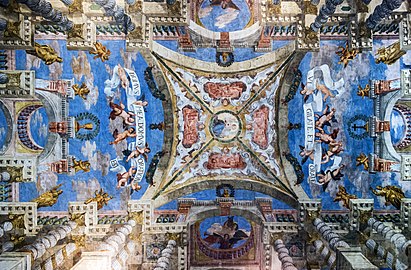Sant'Alvise
| Sant'Alvise | |
|---|---|
Roman Catholic | |
| Province | Venice |
| Location | |
| Location | Venice, Italy |
| Geographic coordinates | 45°26′51″N 12°19′45″E / 45.4475°N 12.3292°E |
| Architecture | |
| Completed | 1338 |
Sant'Alvise is a church in the sestiere of Cannaregio in Venice, northern Italy. The brick exterior and facade do not reflect the rich interior.
History
According to tradition, the church was built, along with the adjoining monastery, by
The church was built on the plan of a basilica. The simple facade is marked by a large doorway made of Istria stone. Above the door is a statue of Saint Alvise from 1400. The original wooden structures were rebuilt in 1430 due in part to the generosity of Pope Martin V. The church was restored in the XVII century, the interior almost completely remodeled. The Gothic bell tower dates from the XIII Century.[2]
Interior
It has a single nave, the current appearance dating from the 17th century restoration. On the interior facade above the entrance porch you can see a "barco". A special piece on the counter-facade. Protected by wrought iron gates, behind which the enclosed nuns could attend the religious services.[2]
-
West Facade on campo
-
Main entrance
-
Statue ofSt. Louis of Toulouse
Art work
The ceiling was entirely frescoed by Pietro Antonio Torri and Pietro Ricchi in 1674.[3]
To the right of the entrance are two canvases by
To the left of the entrance are small 15th-century tempera panels by
The adjacent convent is occupied by the Canossian Daughters of Charity.[6]
-
View of the nave
-
The Barco
-
Heavenly Jerusalem by Pietro Antonio Torri and Pietro Ricchi
-
Saint Louis, sacred, bishop of Toulouse by Pietro Damini
-
Madonna of the Rosary by Giovanni Maria Morlaiter
-
The organ
References
- ^ "Chiesa di Sant'Alvise", Religiana
- ^ a b "The Church of Sant'Alvise", Camera di Commercio di venezia
- ^ a b "Sant'Alvise Church", Associazione per le Chiese del Patriarcato di Venezia
- ^ "Sant'Alvise", Aliusmodi Cultural Association
- ^ "Sant'Alvise", Fodor's
- ^ a b "Sant’Alvise", The Churches of Venice











